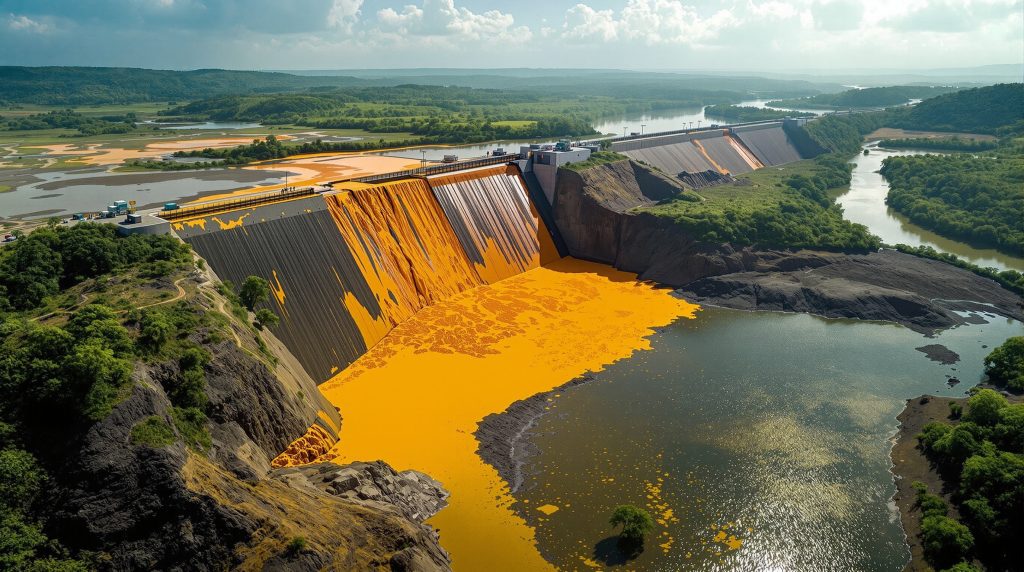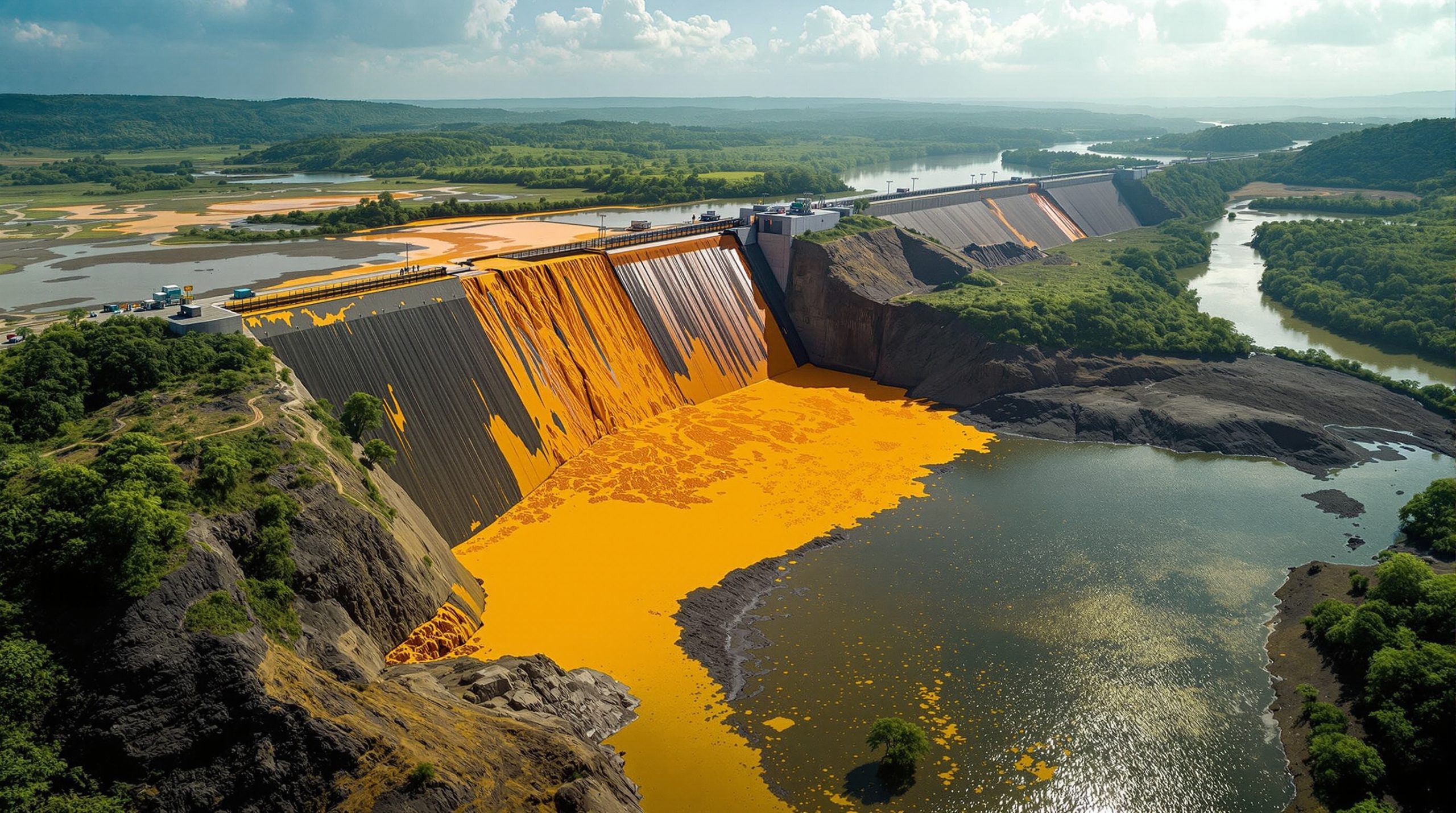What Happened in the Zambia Acid Spill Disaster?
The Initial Incident and Immediate Impact
In February 2025, a catastrophic environmental disaster unfolded near Kitwe, Zambia's second-largest city, when a tailings dam at the Sino Metals Leach Zambia Ltd. facility experienced a significant breach. The incident released approximately 51,800 cubic meters (13.7 million gallons) of acid waste into the surrounding environment, affecting an 8-kilometer stretch from the point of breach, commonly referred to as "ground zero" by response teams.
The proximity to a major urban center immediately raised serious concerns about potential contamination of water sources, soil degradation, and exposure to toxic materials for thousands of residents in the area. Local communities reported unusual discoloration in nearby streams and concerning odors emanating from affected areas.
Conflicting Assessment Reports
One of the most contentious aspects of the Zambia acid spill disaster has been the drastically different assessments of the spill's magnitude. The Zambian government officially backed Sino Metals' estimate of 51,800 cubic meters of toxic material released. However, an independent assessment conducted by Drizit Zambia painted a far more alarming picture, suggesting the actual volume could be as high as 1.5 million tons of toxic material—approximately 30 times the official estimate.
This significant discrepancy raised serious questions about transparency and accountability. Following Drizit's assessment, Sino Metals terminated their contract, further fueling public skepticism about the company's commitment to accurate reporting and environmental responsibility.
In a statement released to the public, Sino Metals rejected Drizit's assessment, claiming it was "misleading and devoid of factual, scientific and technical basis." This stance was supported by Acting Minister of Green Economy and Environment Collins Nzovu, who stood by the lower figure in official communications.
The Zambian government has since announced plans to select a new environmental assessor by September 15, 2025, with work expected to commence by the third week of the month. This move aims to establish a definitive assessment of the disaster's scope, though concerns remain about potential influence over the selection process.
How Has the Government Responded to the Disaster?
Official Statements and Position
The Zambian government's response has been marked by consistent support for Sino Metals' lower estimate of the spill volume. Acting Minister Collins Nzovu publicly backed the company's assessment, stating: "Based on the records that we have, the estimated amount of the acid waste that was released in the open environment was 51,800 cubic meters."
Government officials have firmly denied allegations of a cover-up attempt, with Nzovu emphasizing that tailings dams are "physical features which no one can hide." This statement aimed to reassure the public that the scale of the disaster couldn't be concealed, regardless of official estimates.
Throughout public communications, government representatives have maintained that drinking water remains safe for human consumption despite growing concerns from local communities and international observers. This position has created tension between the government's reassurances and the lived experiences of residents reporting unusual water characteristics and health complaints.
Health Warnings and International Response
The disaster has triggered significant international concern, with multiple foreign embassies issuing health warnings to their citizens in the affected region. The United States and Finland were among the first diplomatic missions to alert their nationals about potential contamination risks, advising caution regarding water consumption and exposure to affected areas.
These diplomatic warnings created a notable contrast with the Zambian government's official position, highlighting international skepticism about the adequacy of the response and the accuracy of government safety assurances.
While maintaining that drinking water was safe, the Zambian government did acknowledge finding dangerous levels of heavy metals in some natural water bodies. This partial admission raised questions about potential downstream contamination and the effectiveness of containment measures.
The international response has placed additional pressure on both Sino Metals and Zambian authorities to ensure transparent assessment and remediation efforts. Environmental organizations have called for independent monitoring mechanisms to verify cleanup progress and water safety claims.
What Environmental and Health Risks Does the Spill Present?
Toxic Materials and Contamination Concerns
The acid waste released from the tailings dam contains a range of hazardous materials that pose serious environmental and health risks. Independent assessments warned that communities near the affected area face daily exposure to potentially dangerous substances including arsenic, cyanide, and uranium—all common byproducts of copper mining operations.
These heavy metals and toxic compounds can persist in the environment for extended periods, with potential to:
- Contaminate groundwater and surface water sources
- Accumulate in soil, affecting agricultural productivity
- Enter the food chain through contaminated crops and fish
- Cause immediate and long-term health effects in exposed populations
- Damage local ecosystems and reduce biodiversity
Government testing has confirmed the presence of heavy metals in some water samples, though officials maintain that drinking water supplies remain unaffected. This distinction between natural water bodies and treated water sources has been a central point in official communications.
The potential for bioaccumulation of these toxic substances in the local ecosystem presents a particularly concerning long-term risk, as contaminants could concentrate in fish, plants, and animals that form part of the local food supply.
Cleanup Operations and Remediation
Sino Metals has begun remediation efforts, focusing initially on removing visible pollution and residue from the 8-kilometer affected zone extending from the breach point. The company has deployed equipment and personnel to contain further spread of contaminants and begin the process of environmental recovery.
However, significant questions remain about:
- The adequacy of current cleanup methods for addressing less visible contamination
- Timeline projections for complete remediation
- Long-term monitoring protocols to ensure environmental recovery
- Independent verification mechanisms for cleanup effectiveness
- Restoration plans for damaged ecosystems
Environmental experts note that mine reclamation innovation often requires specialized techniques beyond simple removal of visible waste, including soil treatment, groundwater remediation, and ecological restoration. The effectiveness of Sino Metals' approach will likely depend on the comprehensiveness of these efforts and the resources dedicated to long-term recovery.
What Are the Economic and Legal Implications?
Financial Responsibility and Damages
The economic implications of the Zambia acid spill are substantial, with reports indicating that the Chinese firm faces potential damage claims reaching $420 million. This figure represents one of the largest environmental liability cases in Zambia's mining sector history.
These potential damages encompass multiple categories:
- Direct cleanup and remediation costs
- Compensation for affected communities
- Economic losses for local businesses dependent on affected resources
- Healthcare costs for treating exposure-related conditions
- Long-term environmental monitoring expenses
- Potential regulatory fines and penalties
For local communities dependent on natural water sources for agriculture, fishing, and daily needs, the economic impact extends beyond immediate damages to potential long-term livelihood disruptions. Small-scale farmers and fishers in the region may face years of reduced productivity and income.
The final cost determination will likely depend on the officially recognized scale of the disaster, highlighting the significance of the ongoing assessment dispute. If the higher estimate of 1.5 million tons is ultimately accepted, the financial liabilities could increase substantially.
Corporate and Diplomatic Relations
The incident has placed strain on Zambia-China economic relations, creating a delicate diplomatic situation for both nations. China has significant investments in Zambia's mining sector, making the handling of the disaster politically sensitive.
The Chinese embassy in Lusaka has actively defended Sino Metals' cooperation efforts, issuing a statement opposing "irresponsible and exaggerated narratives based on fabricated figures or ill-intended smear campaigns for geopolitical gains." This language suggests concern about potential damage to China's broader economic interests in the region.
The statement further emphasized that "Sino Metals has been making all-out efforts to cooperate with the Zambian government in dealing with the tailings dam breach," presenting the company as a responsible corporate actor despite the controversy.
This disaster occurs against a backdrop of increasing global scrutiny of environmental practices in extractive industries, particularly those operating in developing nations. The resolution of this case may set precedents for how similar incidents are handled in the future across Zambia's mining industry evolution.
How Does This Incident Compare to Other Mining Disasters?
Scale and Severity Assessment
The Zambia acid spill represents one of the most significant mining-related environmental incidents in the country's recent history. While smaller in volume than some global mining disasters, its proximity to Kitwe—Zambia's second-largest city—magnifies its potential human impact.
Several factors distinguish this incident:
- Location near a major population center
- Direct impact on water resources used by communities
- Involvement of highly toxic materials including arsenic and cyanide
- Conflicting assessment reports creating uncertainty about true scale
- Proximity to the Copperbelt region, an area already experiencing cumulative environmental impacts from decades of mining activity
The concentrated local impact of the spill—affecting an 8-kilometer stretch from the breach point—creates intensive contamination in a relatively small area, rather than being dispersed across a wider region. This concentration may complicate remediation efforts but could also allow for more focused cleanup operations.
Environmental scientists note that the toxicity profile of the released materials, rather than simply the volume, is a critical factor in determining the disaster's severity. The presence of multiple heavy metals and toxic compounds creates complex remediation challenges and potential synergistic effects in the environment.
Environmental Governance Challenges
The acid spill has exposed potential weaknesses in mining oversight and environmental protection systems in Zambia. Key governance challenges highlighted by the incident include:
- Discrepancies between company self-reporting and independent assessments
- Questions about regulatory independence and capacity to verify corporate claims
- Potential conflicts between economic development priorities and environmental safeguards
- Challenges in ensuring transparent communication during environmental crises
- Limited public access to technical information about mining operations
These governance challenges are not unique to Zambia but reflect broader tensions in resource-rich developing nations balancing economic development through resource extraction with environmental protection. The resolution of this case may influence future approaches to mining claims framework across the region.
The incident also raises questions about the effectiveness of existing regulatory frameworks governing tailings dam construction, monitoring, and emergency response. Mining industry experts note that similar failures have occurred globally, suggesting systemic issues in how these high-risk facilities are managed.
What Lessons Can Be Learned from the Zambia Acid Spill?
Improving Disaster Response Protocols
The conflicting assessments and communications challenges observed in this case highlight the need for improved disaster response protocols in the mining sector. Key improvements could include:
-
Independent assessment mechanisms – Establishing pre-qualified independent assessment teams that can be rapidly deployed following environmental incidents
-
Standardized assessment methodologies – Developing clear technical standards for measuring and reporting contaminant releases
-
Transparent data sharing – Creating platforms for real-time sharing of environmental monitoring data with affected communities
-
Coordinated communication strategies – Ensuring consistent messaging across government agencies, companies, and international organizations
-
Community engagement protocols – Developing frameworks for meaningful inclusion of affected communities in assessment and remediation planning
Environmental emergency response experts emphasize that the critical period immediately following a spill often determines the effectiveness of containment efforts. Having established protocols and pre-positioned resources can significantly reduce environmental damage and human exposure.
The value of international cooperation has also been highlighted, as embassies and international organizations played important roles in raising awareness about potential health risks. Formalizing these channels of communication could improve future responses.
Strengthening Environmental Safeguards
Beyond immediate response improvements, the incident points to needs for strengthened preventive measures:
-
Enhanced tailings dam safety regulations – Updating design standards, inspection frequencies, and safety margin requirements for high-risk facilities
-
Independent monitoring systems – Implementing continuous monitoring technology with direct reporting to regulatory authorities
-
Comprehensive emergency response plans – Requiring detailed contingency planning for various failure scenarios
-
Community-based monitoring networks – Training and equipping local communities to identify early warning signs of potential failures
-
Financial assurance mechanisms – Requiring adequate bonding or insurance to cover potential remediation costs
Mining industry analysts note that investing in preventive measures is typically far more cost-effective than managing disasters after they occur. Modern sensing technologies, improved dam construction techniques, and waste minimization approaches can significantly reduce risks while potentially improving operational efficiency.
The financial implications of the disaster—with potential damages reaching $420 million—provide a compelling business case for enhanced preventive investments across the industry.
FAQ: Zambia Acid Spill Disaster
What caused the acid spill in Zambia?
The disaster occurred when a tailings dam at the Chinese state-owned Sino Metals Leach Zambia Ltd. copper mine facility near Kitwe failed in February 2025. Tailings dams are structures designed to store waste materials from mining operations, and in this case, the dam contained acid waste from copper processing. The specific structural or operational failures that led to the breach were detailed in the BBC's reporting.
How much toxic material was released in the spill?
This remains a point of significant controversy. Official government figures and Sino Metals cite 51,800 cubic meters (13.7 million gallons) of acid waste. However, an independent assessment conducted by Drizit Zambia suggested the figure could be up to 1.5 million tons—approximately 30 times higher than the official estimate. The government plans to select a new assessor to provide an updated evaluation.
What toxic substances were released in the spill?
The spill reportedly contained various hazardous materials commonly associated with copper mining waste, including arsenic, cyanide, uranium, and other heavy metals. These substances can cause both acute health effects upon direct exposure and chronic issues through long-term environmental contamination. The specific concentration and distribution of these toxins across the affected area remain under assessment.
Is drinking water safe in the affected areas?
The Zambian government maintains that drinking water remains safe for human consumption, despite acknowledging dangerous levels of heavy metals in some natural water bodies. Several foreign embassies have issued health warnings that contradict this assessment, advising their citizens to exercise caution. Water safety remains a primary concern for local communities, with independent testing recommended for residents in the affected region.
Who is responsible for the cleanup costs?
Sino Metals Leach Zambia Ltd. is expected to bear the cleanup costs, with potential damage claims reaching up to $420 million according to reports. The company has begun remediation efforts, focusing initially on removing visible pollution from the affected area. The final determination of financial responsibility may depend on regulatory findings regarding compliance with environmental regulations and safety standards prior to the breach.
How long will the environmental recovery take?
The timeline for complete environmental recovery remains uncertain and depends on multiple factors including the effectiveness of cleanup operations, the extent and depth of contamination, the specific types of toxins involved, and the resilience of local ecosystems. Similar mining waste spills globally have required remediation periods ranging from several years to decades, depending on the severity and nature of the contamination.
The Path Forward for Environmental Protection in Zambia
The Zambia acid spill disaster represents a critical juncture for the country's approach to balancing mineral extraction with environmental protection. As cleanup efforts continue and assessments proceed, the incident highlights the need for strengthened regulatory frameworks, independent oversight, and transparent communication during environmental emergencies.
The conflicting assessments between government-backed figures and independent evaluations underscore the importance of credible, third-party environmental monitoring in mining operations. For affected communities, the disaster raises urgent questions about long-term health impacts, economic consequences, and environmental justice.
Effective remediation will require sustained commitment from both Sino Metals and regulatory authorities, with transparent reporting on progress and challenges. Long-term monitoring programs will be essential to track environmental recovery and identify any delayed impacts that may emerge over time.
Beyond this specific incident, the disaster may serve as a catalyst for broader reforms in Zambia's mining sector. Potential areas for improvement include:
- Updating environmental impact assessment requirements for mining operations
- Strengthening community consultation processes for projects with significant environmental risks
- Enhancing technical capacity within regulatory agencies to effectively oversee complex mining operations
- Developing more robust financial assurance mechanisms to ensure funds for cleanup in worst-case scenarios
- Improving emergency preparedness and response capabilities in mining regions
As Zambia continues to develop its substantial mineral resources, particularly copper, the lessons from this incident will likely shape future approaches to mining governance, environmental protection, and crisis management. The international attention drawn by the disaster may also influence how foreign investors approach environmental safeguards in their Zambian operations going forward.
The resolution of this case—including the final determination of the spill's magnitude, the effectiveness of remediation efforts, and the allocation of financial responsibility—will set important precedents for class action governance and uranium market volatility in Zambia's mining sector for years to come.
Worried About Environmental Disasters in the Mining Sector?
Stay ahead of critical mining incidents and discover investment opportunities with Discovery Alert's proprietary Discovery IQ model, which provides real-time notifications of significant ASX mineral discoveries and environmental developments. Visit our discoveries page to understand how major mineral discoveries and environmental challenges can impact market returns.




